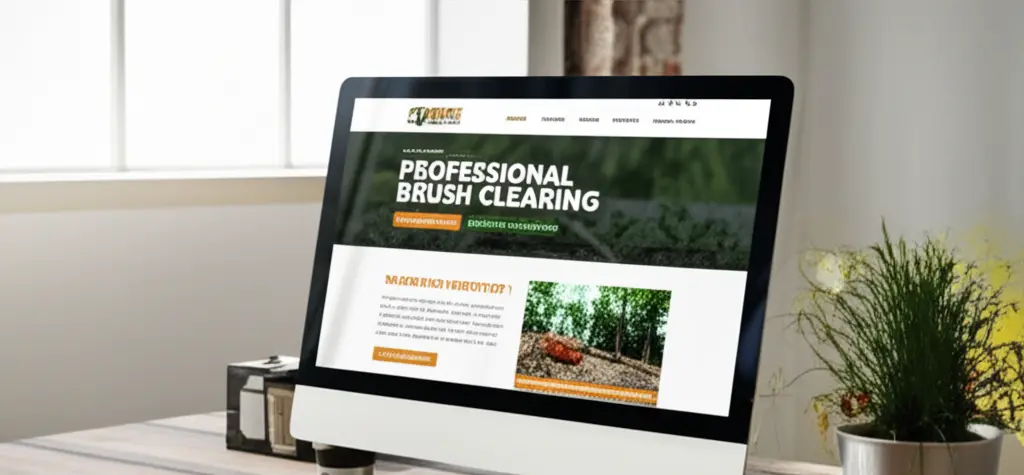




For land clearing contractors, service pages often serve as the first point of contact between a potential client and your business. Unlike a generic homepage, a well-optimized land clearing service page targets specific services—such as brush clearing, forestry mulching, or site preparation—and directly answers the search intent of local property owners.
From a digital marketing perspective, these service pages act as conversion hubs. When optimized properly, they not only appear prominently in search results but also guide visitors toward taking action—such as requesting a quote or scheduling a consultation.
If you neglect service page optimization, your business often remains invisible to potential clients at the exact moment they are actively searching. This difference can be decisive. For example, a land clearing contractor in Texas saw a 40% increase in qualified leads per month after investing in service page optimization. By structuring clear messaging and offering detailed descriptions of forestry mulching and excavation, the business became recognized as a local authority instead of just another listing in an online directory.
Local SEO significantly amplifies the effectiveness of your service pages. Since most clients searching for land clearing are targeting specific regions—from small towns to entire counties—Google’s algorithm prioritizes businesses that demonstrate local relevance. This includes not only service-area keywords but also the integration of Google Maps, local reviews, and mobile-friendly designs.
For instance, a land clearing contractor in North Carolina optimized their site with location-rich content such as “Professional Brush Clearing in Raleigh & Surrounding Areas.” Within four months, their page impressions grew by 75%, while local leads from Google’s ‘near me’ searches accounted for 60% of new inquiries.
Essentially, service pages that incorporate local SEO transcend generic marketing—they position your company as the go-to provider for land clearing projects in your area. With that foundation in place, the next step is structuring your service pages to convert traffic into paying customers.
The most successful land clearing service pages share several key traits:
1. Keyword-focused headlines: Titles like “Professional Land Clearing Services in Knoxville, TN” immediately establish relevance while targeting high-value search terms.
2. Detailed service descriptions: Instead of vague bullet points, each service type should be fully explained. Brush clearing, forestry mulching, and site preparation can each have short explanatory sections outlining methods, benefits, and suitable project types.
3. Calls-to-action (CTAs): Every page should have strategically placed CTAs such as “Request a Free On-Site Estimate” or “Schedule Consultation Today.” Placing them multiple times—at the top, middle, and bottom—allows visitors to convert at any stage of their journey.
Taken together, these elements transform service pages from mere informational listings into high-converting digital sales tools.
User experience can make or break your website. If pages are hard to navigate, load slowly, or fail on mobile devices, potential customers leave immediately—and competitors gain the advantage.
The best-performing pages emphasize trust with visual trust signals like licensing information, safety certifications, and “insured contractor” badges. Integration of real client testimonials or video reviews provides authentic credibility.
Equally important is speed and responsiveness. Given that over 60% of local service searches come from mobile devices, service pages must adapt seamlessly to small screens while keeping load times under three seconds. Businesses that have upgraded their sites to mobile-first designs report reductions in bounce rates by up to 30%.
Static service pages are less effective than dynamic, interactive ones. By integrating smart tools and features, you capture higher-quality leads and showcase professionalism.
For example, offering an automated quote request form allows property owners to input project details—such as acreage size, vegetation type, and project timeframe—and receive prompt responses. This convenience not only generates leads but also qualifies them for your business.
Adding cost estimators or project timeline widgets provides potential clients with instant expectations. One Florida-based land clearing company implemented a simple “timeline calculator” and saw engagement rates triple, as customers used the feature to visualize project planning.
As UX and interactivity converge, your service page evolves into a powerful pre-sales environment, moving prospects down the funnel before initial contact.
Visual storytelling is one of the most effective strategies for your service pages. Before-and-after galleries demonstrate measurable project impacts—turning unused, overgrown land into ready-to-build lots or agricultural spaces.
Case in point: an excavation contractor in Georgia dedicated a separate section of their site to transformation stories. Within three months, average time-on-page increased from 1:45 minutes to over 3 minutes, indicating that visitors were highly engaged with visual proof of results.
Most competitors highlight only machines and manpower, but environmentally conscious customers are increasingly influenced by sustainable practices. Highlighting compliance with soil conservation practices, erosion prevention methods, and tree-preservation policies can differentiate your brand.
For example, mentioning forestry mulchers that minimize soil disturbance or excavators equipped with low-emissions engines demonstrates a commitment to environmental responsibility. Contractors who transparently share these practices often see higher conversion rates among eco-conscious property developers and municipalities.
Copywriting should blend keyword optimization with persuasive storytelling. Primary terms like “land clearing service pages” or “professional land clearing services” help Google understand content, while location modifiers such as “in Dallas County” or “near Asheville” align with searcher intent.
Professional copy avoids overuse of repetitive keywords but naturally integrates them into service descriptions, CTAs, and section headers. This balance signals authority to search engines without alienating human readers.
Together, storytelling, environmental insights, and SEO-focused copy create service pages that rank higher and resonate more deeply with prospective clients.
If your company serves multiple areas, a single generic service page will limit your reach. Instead, build individual location-based pages—each featuring unique content tied to actual projects, testimonials, or geographic landmarks.
For instance, a contractor who created city-specific pages for “Land Clearing in Athens, GA” and “Brush Clearing in Augusta, GA” increased regional search impressions by 85% within six months.
Structured data, or schema markup, provides Google with detailed metadata about your services, locations, and contact information. By labeling sections of your service pages, you enable rich snippets—such as “Rated 5 stars” or “Serving Austin County”—to appear directly within search results. Businesses leveraging service schema report click-through rates 20–30% higher than competitors without it.
Local SEO impact doesn’t end with on-page changes. Building trust across the web through backlinks and citations strengthens visibility. Partnering with directories like HomeAdvisor or regional business networks provides credibility signals, while encouraging clients to leave Google reviews helps boost rankings.
These elements collectively expand your online presence, ensuring not only visibility but also authority in local search ecosystems.
One of the key pitfalls for contractors expanding with multiple service area pages is repetitive, near-duplicate content. Search engines may downrank sites that copy-paste entire sections. Instead, write unique content for each region, incorporating context such as soil types, typical vegetation challenges, and climate considerations.
This not only prevents penalties but communicates to clients that you understand the specifics of their local environment.
Optimization is not a one-off task—it requires continuous refinement. Google Analytics allows you to track bounce rates, conversion percentages, and time on site, while Search Console surfaces the highest-performing keywords and queries.
A company monitoring these insights improved conversions by 22% simply by repositioning CTAs that heatmap analysis showed customers rarely scrolled down to see. Regular refinement ensures that service pages adapt to real-world browsing behavior.
Trust is an essential driver in contracting decisions. Your service pages should prominently display certifications, safety protocols, and warranty policies. Adding video testimonials or detailed case study write-ups can establish authority further.
For instance, a contractor advertised compliance with U.S. Forest Service vegetation management standards. This positioning helped them win a $2.5M municipal contract, proving the ROI of promoting authority credentials directly on service pages.
WordPress remains the most common CMS for land clearing contractor websites due to its SEO capabilities. Plugins like Yoast SEO assist with meta optimization, while WP Rocket boosts page speed. For schema integration, tools like Schema Pro allow simple setup of service and local business markups.
Other website builders such as Webflow or Squarespace can also work for smaller contractors, though cost and customization limitations may hinder complex optimization.
Measuring success requires layered analytics:
Heatmaps (Hotjar, Crazy Egg): Reveal where visitors are clicking or ignoring CTAs.
Keyword Tracking (SEMrush, Ahrefs): Monitors which location-based keywords generate ranking improvements.
Review Monitoring Tools (BrightLocal): Track local citations and manage review generation across directories.
Using these tools together offers a holistic view, ensuring your service pages not only attract visitors but convert them into loyal customers.
